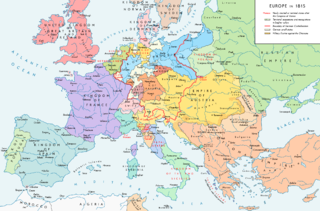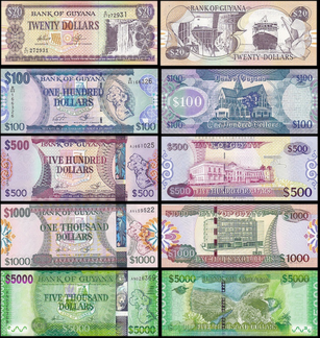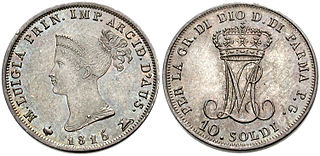This article relies largely or entirely on a single source .(June 2019) |
An extremely rare banknote that was issued in 1815 at Fort Michilimackinac, Michigan, United States, by an occupation force from the British Army.
This article relies largely or entirely on a single source .(June 2019) |
An extremely rare banknote that was issued in 1815 at Fort Michilimackinac, Michigan, United States, by an occupation force from the British Army.

The Congress of Vienna was a meeting of ambassadors of European states chaired by Austrian statesman Klemens von Metternich, and held in Vienna from November 1814 to June 1815, though the delegates had arrived and were already negotiating by late September 1814. The objective of the Congress was to provide a long-term peace plan for Europe by settling critical issues arising from the French Revolutionary Wars and the Napoleonic Wars. The goal was not simply to restore old boundaries but to resize the main powers so they could balance each other and remain at peace. The leaders were conservatives with little use for republicanism or revolution, both of which threatened to upset the status quo in Europe. France lost all its recent conquests while Prussia, Austria and Russia made major territorial gains. Prussia added smaller German states in the west, Swedish Pomerania and 60% of the Kingdom of Saxony; Austria gained Venice and much of northern Italy. Russia gained parts of Poland. The new Kingdom of the Netherlands had been created just months before, and included formerly Austrian territory that in 1830 became Belgium.

The Battle of New Orleans was fought on January 8, 1815 between the British Army under Major General Sir Edward Pakenham and the United States Army under Brevet Major General Andrew Jackson. It took place approximately 5 miles east-southeast of the center of the original city of New Orleans, close to the town of Chalmette, Louisiana, and it was a U.S. victory.

The Treaty of Paris of 1815 was signed on 20 November 1815 following the defeat and second abdication of Napoleon Bonaparte. In February, Napoleon had escaped from his exile on Elba; he entered Paris on 20 March, beginning the Hundred Days of his restored rule. After France's defeat at the hands of the British and the Prussians in the Battle of Waterloo, Napoleon was persuaded to abdicate again, on 22 June. King Louis XVIII, who had fled the country when Napoleon arrived in Paris, took the throne for a second time on 8 July.

A banknote is a type of negotiable promissory note, made by a bank, payable to the bearer on demand. Banknotes were originally issued by commercial banks, which were legally required to redeem the notes for legal tender when presented to the chief cashier of the originating bank. These commercial banknotes only traded at face value in the market served by the issuing bank. Commercial banknotes have primarily been replaced by national banknotes issued by central banks.
The Panic of 1819 was the first financial crisis in the United States. It was followed by a general collapse of the American economy that persisted through 1821. The Panic heralded the transition of the nation from its colonial commercial status with Europe toward an independent economy.
Prize money refers in particular to naval prize money, usually arising naval warfare, but also in other circumstances. It was a monetary reward paid in accordance with the prize law of a belligerent state to the crew of a ship belonging to the state, either a warship of its navy or a privateer vessel commissioned by the state. Prize money was most frequently awarded for the capture of enemy ships or of cargoes belonging to an enemy in time of war, either arrested in port at the outbreak of war or captured during the war in international waters or other waters not the territorial waters of a neutral state. Goods carried in neutral ships that are classed as contraband, being shipped to enemy-controlled territory and liable to be useful to it for making war, were also liable to be taken as prizes, but non-contraband goods belonging to neutrals were not. Claims for the award of prize money were usually heard in a Prize Court, which had to adjudicate the claim and condemn the prize before any distribution of cash or goods could be made to the captors.
The early Canadian banking system was regulated entirely by the colonial government. Primitive forms of banking emerged early in the colonial period to solve the drain of wealth caused by the application of mercantilist theory. The drain of wealth translated into a complete lack of gold or silver bullion in the colonies, and thus, a complete lack of forms of economic exchange and payment.

The Guyanese dollar has been the unit of account in Guyana since 29 January 1839. Originally it was intended as a transitional unit to facilitate the changeover from the Dutch guilder system of currency to the British pound sterling system. The Spanish dollar was already prevalent throughout the West Indies in general, and from 1839, the Spanish dollar unit operated in British Guiana in conjunction with British sterling coins at a standard conversion rate of one dollar for every four shillings and twopence. In 1951 the British sterling coinage was replaced with a new decimal coinage which was simultaneously introduced through all the British territories in the Eastern Caribbean. When sterling began to depreciate in the early 1970s, a switch to a US dollar peg became increasingly attractive as an anti-inflationary measure and the Eastern Caribbean Currency Authority made the switch in October 1975. The Guyanese dollar is normally abbreviated with the dollar sign $, or alternatively G$ to distinguish it from other dollar-denominated currencies.

The United States large cent was a coin with a face value of 1/100 of a United States dollar. Its nominal diameter was 11⁄8 inch (28.57 mm). The first official mintage of the large cent was in 1793, and its production continued until 1857, when it was officially replaced by the modern-size one-cent coin.

The rigsdaler was the name of several currencies used in Denmark until 1875. The similarly named Reichsthaler, riksdaler and rijksdaalder were used in Germany and Austria-Hungary, Sweden and the Netherlands, respectively. These currencies were often anglicized as rix-dollar or rixdollar.
The rixdollar was the currency of British Ceylon until 1828. It was subdivided into 48 stivers, each of 4 duit. Units called the fanam and larin were also used, worth 4 and 9½ stiver, respectively. The currency derived from the Dutch rijksdaalder and stuiver, although the rijksdaalder was worth 50 stuiver. The rixdollar was replaced by the British pound at a rate of 1 rixdollar = 1 shilling 6 pence.

The Magdalen Island penny token was a token that was originally issued for use on that island and throughout Lower Canada and the Maritime Provinces in the early 19th century. This token was issued in 1815 by Sir Isaac Coffin, who was granted the island by the British government in reward for his loyalty to the crown during the American Revolutionary War. While not a rare coin, it is hard to find in anything but worn condition, and even prices for pieces in the lowest grades tend to start at about at about C$100 and go up rapidly from there.

The Bank Charter Act 1844, sometimes referred to as the Peel Banking Act of 1844, was an Act of the Parliament of the United Kingdom, passed under the government of Robert Peel, which restricted the powers of British banks and gave exclusive note-issuing powers to the central Bank of England. It is one of the Bank of England Acts 1694 to 1892.
The fanam was a currency issued by the Madras Presidency until 1815. It circulated alongside the Indian rupee, also issued by the Presidency. The fanam was a small silver coin, subdivided into 80 copper cash, with the gold pagoda worth 42 fanams. The rupee was worth 12 fanams. After 1815, only coins of the rupee currency system were issued.

The lira was the distinct currency of Parma before 1802 and again from 1815 to 1859.
The Law of the General Maximum was instituted during the French Revolution on 29 September 1793, setting price limits and punishing price gouging in order to ensure the continued supply of food to the French people. It was enacted as an extension of the Law of Suspects of 17 September, and succeeded the Law of the Maximum of 4 May 1793, which served a similar purpose.

The rigsdaler was the unit of currency used in Norway until 1816 and in Denmark until 1873. The similarly named Reichsthaler, riksdaler and rijksdaalder were used in Germany and Austria-Hungary, Sweden and the Netherlands, respectively.
The Panic of 1825 was a stock market crash that started in the Bank of England, arising in part out of speculative investments in Latin America, including an imaginary country: Poyais. The crisis was felt most acutely in Britain, where it led to the closure of six London and sixty country banks in England. It was also manifest in the markets of Europe, Latin America and the United States. An infusion of gold reserves from the Banque de France saved the Bank of England from complete collapse. The panic has been described as the first modern economic crisis not attributable to an external event, such as a war, and so the start of modern economic cycles. The Napoleonic Wars had been exceptionally profitable for all sectors of the British financial system, and the expansionist monetary actions taken during transition from war to peace brought on a surge of prosperity and speculative ventures. The stock market boom became a bubble and banks caught up in the euphoria made risky loans.

HMS Weazel was a Royal Navy 18-gun Cruizer-class brig-sloop, launched in 1805 at Topsham, Devon. She saw active service in and around the Mediterranean during the Napoleonic Wars resulting in her crews earning three clasps to the Naval General Service Medal, was decommissioned in 1815, and was sold for breaking in 1825.

A Treasury Note is a type of short term debt instrument issued by the United States prior to the creation of the Federal Reserve System in 1913. Without the alternatives offered by a federal paper money or a central bank, the U.S. government relied on these instruments for funding during periods of financial stress such as the War of 1812, the Panic of 1837, and the American Civil War. While the Treasury Notes, as issued, were neither legal tender nor representative money, some issues were used as money in lieu of an official federal paper money. However the motivation behind their issuance was always funding federal expenditures rather than the provision of a circulating medium. These notes typically were hand-signed, of large denomination, of large dimension, bore interest, were payable to the order of the owner, and matured in no more than three years – though some issues lacked one or more of these properties. Often they were receivable at face value by the government in payment of taxes and for purchases of publicly owned land, and thus "might to some extent be regarded as paper money." On many issues the interest rate was chosen to make interest calculations particularly easy, paying either 1, 1½, or 2 cents per day on a $100 note.
Standard Catalog of World Paper Money, Specialized Issues (10th Edition). Edited by George S. Cuhaj. Published by Krause Publications.
| This Banknote-related article is a stub. You can help Wikipedia by expanding it. |